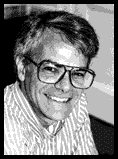|
|
Despite significant advances in understanding basic human disease pathogenesis - and the public's rightful demand for translation of these basic findings into improved diagnosis and treatment of disease - economic factors are making it tough to conduct clinical research in the United States. At NIH, we've witnessed declining morale among our clinical researchers and an increasing concern over how this affects our ability to recruit beginning researchers to dedicate their careers to this goal. What can we do to reverse these trends?
We are currently witnessing a whirlwind of activity at NIH devoted to improving the climate for doing clinical research here: we want to recruit and retain more dedicated clinical researchers. Most of these activities are in the fact-finding stage - thus the plethora of committees. But some concrete actions have already been taken.
The most obvious problem affecting morale and retention of our NIH clinical researchers is that salaries simply do not reach the level accorded equivalent work in the private sector - indeed, they may be falling further behind. This inequity is being addressed through Title 38, a means of supplementing the salaries of physician-researchers who spend a substantial portion of their time (more than 10%) in direct patient contact. As of this writing, 115 clinical researchers at NIH have benefited from salary increases under this authority. And we recently succeeded in extending Title 38 salary supplements to NIH physicians who have medical responsibility for large-scale interventional clinical trials. Through this mechanism, we have been able to secure salaries comparable to midlevel pay scales for academic clinicians, as tabulated by the American Association of Medical Colleges.
A second obvious obstacle to recruitment is the burden of debt that limits career choices for many medical students. NIH currently has three loan repayment programs (LRPs) to overcome this obstacle: an AIDS research LRP, which has supported 96 researchers; a clinical research LRP, designed specifically for disadvantaged clinicians, supporting 32 researchers; and a new LRP for research generally, which currently supports 22 researchers, half of whom do substantial clinical work. Contact Marc Horowitz at the Office of Loan Repayment and Scholarship for guidance (402-5666).
The decision to build a new Clinical Research Center to replace our aging and inefficient infrastructure represents perhaps the most direct and far-reaching step to support clinical research at NIH. Among recommendations for the new center's operations, offered by the NIH Options Team, are that a "Board of Governors" oversee the Clinical Research Center's financial management and that the budget for the center be as stable as the NIH intramural budget itself (a recommendation recently translated into a three-year pilot plan to shape a budget process).
|
WE ARE CURRENTLY WITNESSING A WHIRLWIND OF |
The dejection of our clinical researchers, however, may reflect deeper problems than money, new facilities, or more training opportunities can eliminate. One of the issues of which I recently became aware is a sense among clinical researchers that there is a "double standard" for evaluation and review of clinical research. Some of this feeling derives from the very complex rules established to protect human subjects in the conduct of clinical research, as well as from my recent urging that there be significant pre-IRB review of clinical research protocols. To define and address this perception and other similarly difficult problems, I have asked Steve Straus, of NIAID, to chair a Committee on Recruitment and Career Development of Clinical Researchers at NIH. This committtee will evaluate the current status of our researchers, including the various personnel mechanisms for their support and the extent of clinical research activities on campus.
We're also determined that the public be reminded every so often of the high quality and public health importance of our clinical research programs, and we are planning a series of events that will serve this objective. The first of these - Clinical Research Day, on February 10, 1997 - celebrates the past, present, and future triumphs of clinical research at NIH, showcasing the plans for the new Mark O. Hatfield Clinical Research Center, current research activities, and projections into the next century. In the fall of 1997, we will have a glorious ground-breaking celebration for the new Clinical Research Center, also with a view toward letting the public know the scope and promise of the clinical research conducted on this campus.
I do not know that these ongoing activities will solve all of the problems of our clinical researchers, but I do know that we all need to work together to ensure that clinical research continues to be a vigorous, intellectually stimulating, and effective component of our intramural program. I welcome your thoughts about these issues, which can be sent to me or to The NIH Catalyst in response to the "Call for Catalytic Reactions" on the back page of this issue.
Michael Gottesman
Deputy Director for Intramural Research
